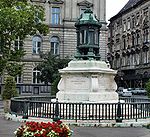SMS Leitha or Lajta Monitor Museumship was the first river monitor in Europe and the oldest and also the only remaining, fully restored warship of the Austro-Hungarian Navy. Currently it is moored on the Danube in Budapest near the Hungarian Parliament Building as a museum ship.
The monitor was an innovation in the history of warship construction. The first European river monitors were constructed by the Austro-Hungarian Monarchy, namely the SMS Leitha and SMS Maros, and since then the river warships of the Monarchy were built in pairs. According to the customs of that time, river warships were named after the rivers of the Austro-Hungarian Empire. The names were chosen to reflect the dual (Imperial and Royal, Austrian and Hungarian) nature of the monarchy; thus, one of the ships received an Austrian name, the other one a Hungarian. This is the reason why this warship was named after the Austrian river Leitha (in Hungarian "Lajta"), while her sister ship was named after a Hungarian river, the Maros.
The construction of the first Danube monitors was dictated by the Monarchy's foreign policy ambitions, and the military and economic situation of the times. The ambition of becoming a great continental power, turned the attention of the Austro-Hungarian Monarchy in the direction of the Balkans as it could not expand towards the West. However, the Monarchy had to be prepared to compensate the states along the Danube, which had been newly liberated from Turkish rule, and that of Czarist Russia. To gain more influence in the Balkans therefore the commander of the Monarchy's naval fleet, admiral Wilhelm von Tegetthoff suggested the construction of monitor type warships. Finances were raised, the necessary funds having been voted from the budget of 1869. The cost of the Leitha amounted to 425,000 florins.











